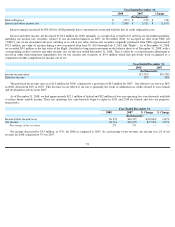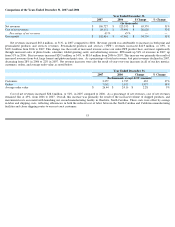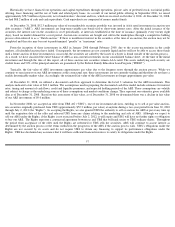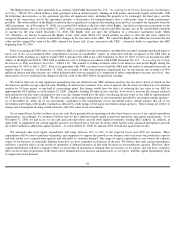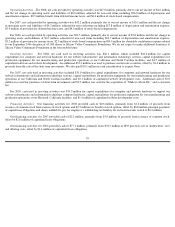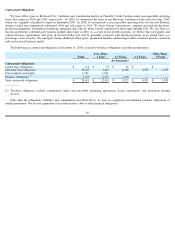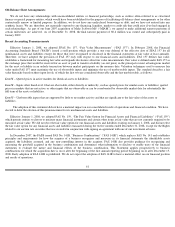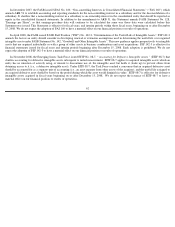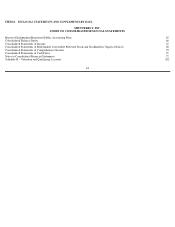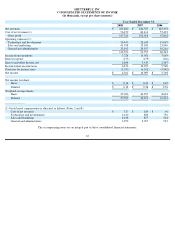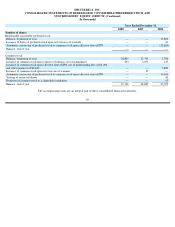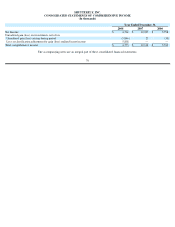Shutterfly 2009 Annual Report Download - page 63
Download and view the complete annual report
Please find page 63 of the 2009 Shutterfly annual report below. You can navigate through the pages in the report by either clicking on the pages listed below, or by using the keyword search tool below to find specific information within the annual report.
Off-Balance Sheet Arrangements
We do not have any relationships with unconsolidated entities or financial partnerships, such as entities often referred to as structured
finance or special purpose entities, which would have been established for the purpose of facilitating off-
balance sheet arrangements or for other
contractually narrow or limited purposes. In addition, we do not have any undisclosed borrowings or debt, and we have not entered into any
synthetic leases. We are, therefore, not materially exposed to any financing, liquidity, market or credit risk that could arise if we had engaged in
such relationships. As part of our June 2007 acquisition of Make It About Me! (“MIAM”),
we agreed to make additional earnout payments if
certain milestones are achieved. As of December 31, 2008, the final earnout payment of $0.4 million was earned and subsequently paid in
January 2009.
Recent Accounting Pronouncements
Effective January 1, 2008, we adopted SFAS No. 157, “Fair Value Measurements” (“FAS 157”).
In February 2008, the Financial
Accounting Standards Board ("FASB") issued a staff position which provides a one year deferral of the effective date of SFAS 157 for all
nonfinancial assets and liabilities except for those that were recognized or disclosed in the financial statements at fair value at least annually.
Therefore, we have adopted the provision of FAS 157 only with respect to our financial assets and liabilities. FAS 157 defines fair value,
establishes a framework for measuring fair value and expands disclosures about fair value measurements. Fair value is defined under FAS 157 as
the exchange price that would be received for an asset or paid to transfer a liability (an exit price) in the principal or most advantageous market
for the asset or liability in an orderly transaction between market participants on the measure date. Valuation techniques used to measure fair
value under FAS 157 must maximize the use of observable inputs and minimize the use of unobservable inputs. The standard describes a fair
value hierarchy based on three input levels, of which the first two are considered observable and the last unobservable, as follows:
Level 1
– Quoted prices in active markets for identical assets or liabilities
Level 2
– Inputs other than Level 1 that are observable, either directly or indirectly, such as quoted prices for similar assets or liabilities; quoted
prices in markets that are not active; or other inputs that are observable or can be corroborated by observable market data for substantially the
full term of the assets or liabilities.
Level 3
– Unobservable inputs that are supported by little or no market activity and that are significant to the fair value of the assets or
liabilities.
The adoption of this statement did not have a material impact on our consolidated results of operations and financial condition. We have
elected to defer the election of this pronouncement for its nonfinancial assets and liabilities.
Effective January 1, 2008, we adopted FAS No. 159, “The Fair Value Option for Financial Assets and Financial Liabilities” (“FAS 159”
)
which permits entities to choose to measure many financial instruments and certain other items at fair value that are not currently required to be
measured at fair value. We did not elect the fair value option for our financial assets and liabilities existing on January 1, 2008, and did not elect
the fair value option for any financial assets and liabilities transacted during the twelve months ended December 31, 2008, except for the Rights
related to our auction rate securities that was recorded in conjunction with signing an agreement with one of our investment advisors.
In December 2007, the FASB issued FAS No. 141R, “Business Combinations” (“FAS 141R”)
which replaces FAS No. 141 and establishes
principles and requirements for how the acquirer of a business recognizes and measures in its financial statements the identifiable assets
acquired, the liabilities assumed, and any non-
controlling interest in the acquiree. FAS 141R also provides guidance for recognizing and
measuring the goodwill acquired in the business combination and determines what information to disclose to enable users of the financial
statements to evaluate the nature and financial effects of the business combination. This Statement applies prospectively to business
combinations for which the acquisition date is on or after the beginning of the first annual reporting period beginning on or after December 15,
2008. Early adoption of FAS 141R is prohibited. We do not expect the adoption of FAS 141R to have a material effect on our financial position
and results of operations.
61



